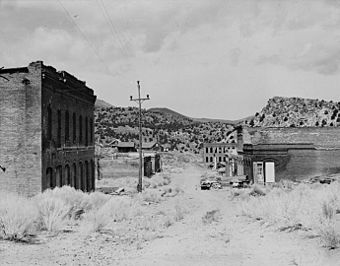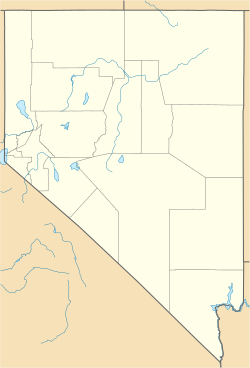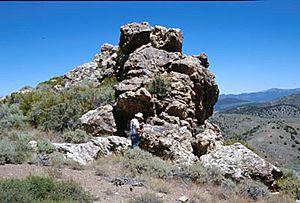Aurora, Nevada facts for kids
Quick facts for kids |
|
|
Aurora
|
|

Aurora, circa 1934
|
|
| Nearest city | Hawthorne, Nevada |
|---|---|
| Built | 1860 |
| NRHP reference No. | 74001147 |
| Added to NRHP | July 30, 1974 |
Aurora is a ghost town located in Mineral County, Nevada. It's in the western part of the state, about 22 miles southwest of Hawthorne. The town is also very close to the California border. A ghost town is a place where most people have left, and many buildings are empty or gone.
Today, not much is left of Aurora. The site has been damaged over time. After World War II, many buildings were taken apart. Their bricks were used to build homes in other places. The road to Aurora used to be hard to travel. Winter snows and spring floods often damaged it. Now, a nearby mine has improved the road. This makes it easier for regular cars to reach the town site.
Contents
The Story of Aurora
How Aurora Began
Three men named James M. Cory, James M. Braly, and E.R. Hicks started Aurora in 1860. When Esmeralda County was created a few years later, Aurora was one of the first places explored there. Cory is said to have first named the mining area "Esmeralda." Later, in the late 1860s, he reportedly changed the name to Aurora. This name comes from the Roman goddess of dawn.
Aurora's Busy Days
At one point, about 10,000 people lived in Aurora. The town's mines produced a lot of gold. By 1869, they had found gold worth $27 million. This was a huge amount of money back then!
The town had a unique problem. Both California and Nevada claimed it. For a while, Aurora was the county seat for two different counties at the same time. It was the county seat for Mono County, California and also for Esmeralda County, Nevada. This meant that leaders from both states represented Aurora. For example, Aurora's representative in the California government was a top speaker. At the same time, its Nevada representative was a president in the Nevada Territorial Legislature.
What Happened to the Town
Over the years, the town cemetery has been damaged. Some headstones have been broken or moved. This shows how much the town has changed since its busy mining days.
What Aurora Looks Like Today
Not much remains of Aurora now. You can still see the old streets. The foundations of some buildings are also visible. Most of the buildings were taken apart. Their materials, especially bricks, were used in homes in California. This happened because used bricks became popular for building.
Famous People from Aurora
- Mark Twain lived in Aurora for a short time around 1862. Later, people in the area used his connection to encourage visitors. They hoped to attract tourists and sell souvenirs.
See also
 In Spanish: Aurora (Nevada) para niños
In Spanish: Aurora (Nevada) para niños





